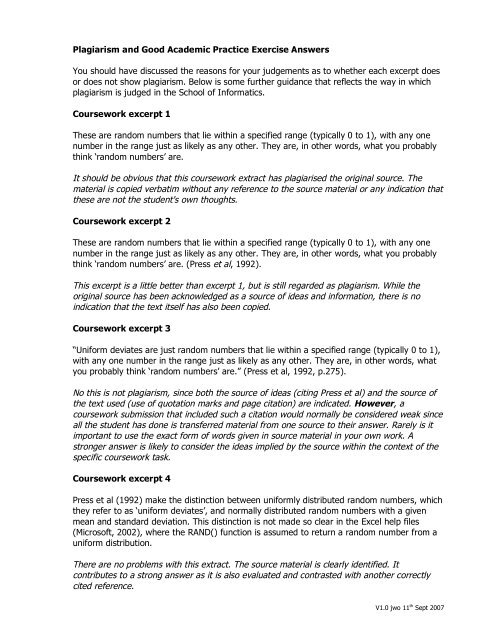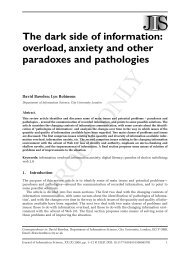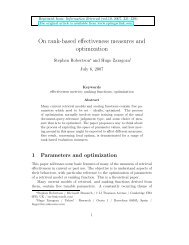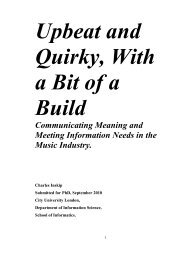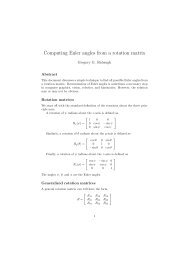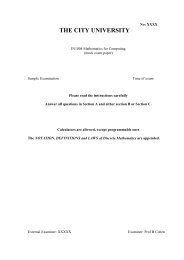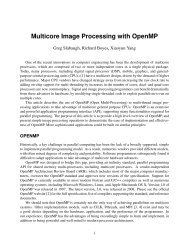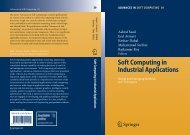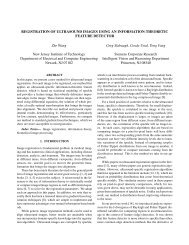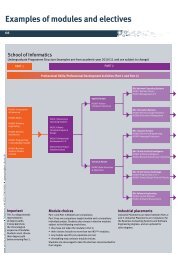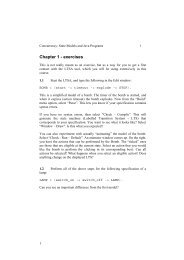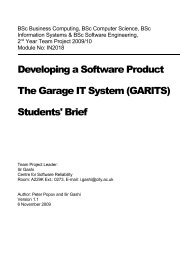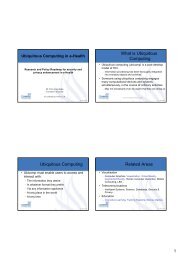Worksheet with answers and context for students - School of ...
Worksheet with answers and context for students - School of ...
Worksheet with answers and context for students - School of ...
You also want an ePaper? Increase the reach of your titles
YUMPU automatically turns print PDFs into web optimized ePapers that Google loves.
Plagiarism <strong>and</strong> Good Academic Practice Exercise Answers<br />
You should have discussed the reasons <strong>for</strong> your judgements as to whether each excerpt does<br />
or does not show plagiarism. Below is some further guidance that reflects the way in which<br />
plagiarism is judged in the <strong>School</strong> <strong>of</strong> In<strong>for</strong>matics.<br />
Coursework excerpt 1<br />
These are r<strong>and</strong>om numbers that lie <strong>with</strong>in a specified range (typically 0 to 1), <strong>with</strong> any one<br />
number in the range just as likely as any other. They are, in other words, what you probably<br />
think ‘r<strong>and</strong>om numbers’ are.<br />
It should be obvious that this coursework extract has plagiarised the original source. The<br />
material is copied verbatim <strong>with</strong>out any reference to the source material or any indication that<br />
these are not the student's own thoughts.<br />
Coursework excerpt 2<br />
These are r<strong>and</strong>om numbers that lie <strong>with</strong>in a specified range (typically 0 to 1), <strong>with</strong> any one<br />
number in the range just as likely as any other. They are, in other words, what you probably<br />
think ‘r<strong>and</strong>om numbers’ are. (Press et al, 1992).<br />
This excerpt is a little better than excerpt 1, but is still regarded as plagiarism. While the<br />
original source has been acknowledged as a source <strong>of</strong> ideas <strong>and</strong> in<strong>for</strong>mation, there is no<br />
indication that the text itself has also been copied.<br />
Coursework excerpt 3<br />
“Uni<strong>for</strong>m deviates are just r<strong>and</strong>om numbers that lie <strong>with</strong>in a specified range (typically 0 to 1),<br />
<strong>with</strong> any one number in the range just as likely as any other. They are, in other words, what<br />
you probably think ‘r<strong>and</strong>om numbers’ are.” (Press et al, 1992, p.275).<br />
No this is not plagiarism, since both the source <strong>of</strong> ideas (citing Press et al) <strong>and</strong> the source <strong>of</strong><br />
the text used (use <strong>of</strong> quotation marks <strong>and</strong> page citation) are indicated. However, a<br />
coursework submission that included such a citation would normally be considered weak since<br />
all the student has done is transferred material from one source to their answer. Rarely is it<br />
important to use the exact <strong>for</strong>m <strong>of</strong> words given in source material in your own work. A<br />
stronger answer is likely to consider the ideas implied by the source <strong>with</strong>in the <strong>context</strong> <strong>of</strong> the<br />
specific coursework task.<br />
Coursework excerpt 4<br />
Press et al (1992) make the distinction between uni<strong>for</strong>mly distributed r<strong>and</strong>om numbers, which<br />
they refer to as ‘uni<strong>for</strong>m deviates’, <strong>and</strong> normally distributed r<strong>and</strong>om numbers <strong>with</strong> a given<br />
mean <strong>and</strong> st<strong>and</strong>ard deviation. This distinction is not made so clear in the Excel help files<br />
(Micros<strong>of</strong>t, 2002), where the RAND() function is assumed to return a r<strong>and</strong>om number from a<br />
uni<strong>for</strong>m distribution.<br />
There are no problems <strong>with</strong> this extract. The source material is clearly identified. It<br />
contributes to a strong answer as it is also evaluated <strong>and</strong> contrasted <strong>with</strong> another correctly<br />
cited reference.<br />
V1.0 jwo 11 th Sept 2007
Coursework excerpt 5<br />
Uni<strong>for</strong>m deviates are simply r<strong>and</strong>om values that exist <strong>with</strong>in a particular range (usually 0 to 1)<br />
where any number is as likely as any other. Such numbers are probably what most people<br />
consider as ‘r<strong>and</strong>om numbers’ (Press et al, 1992)..<br />
This is an important extract to consider. It would normally be regarded as an example <strong>of</strong><br />
plagiarism. While the original assertion made by Press et al is cited correctly, there is still a<br />
similarity in the <strong>for</strong>m <strong>of</strong> text between the extract <strong>and</strong> original source. Cosmetic changes to a<br />
few words are not sufficient to justify the impression that this is entirely the student's own<br />
words.<br />
Coursework excerpt 6<br />
Uni<strong>for</strong>m deviates, which are commonly ranged between 0 <strong>and</strong> 1, consist <strong>of</strong> r<strong>and</strong>om numbers<br />
such that each is as likely to be generated as any other. It is this <strong>for</strong>m <strong>of</strong> r<strong>and</strong>omness that is<br />
most <strong>of</strong>ten thought <strong>of</strong> as ‘r<strong>and</strong>om’. But it is useful to distinguish this from other <strong>for</strong>ms <strong>of</strong><br />
r<strong>and</strong>om distribution such as a Gaussian distribution <strong>with</strong> a given mean <strong>and</strong> st<strong>and</strong>ard deviation<br />
(Press et al, 1992)..<br />
Like excerpt 5, this again would be considered plagiarism. There is evidence that the text <strong>of</strong><br />
the source has been used to generate the extract, <strong>with</strong> some word substitution <strong>of</strong> small parts<br />
<strong>of</strong> it.<br />
Coursework excerpt 7<br />
We can distinguish between two classes <strong>of</strong> r<strong>and</strong>om distributions. Uni<strong>for</strong>m deviates, which are<br />
commonly ranged between 0 <strong>and</strong> 1, consist <strong>of</strong> r<strong>and</strong>om numbers equally probable <strong>of</strong> selection.<br />
In contrast, a Gaussian distribution, defined by a mean <strong>and</strong> st<strong>and</strong>ard deviation, will have an<br />
unequal likelihood <strong>of</strong> any given number being selected. While there is a role <strong>for</strong> both <strong>for</strong>ms <strong>of</strong><br />
r<strong>and</strong>om number generation, it is the <strong>for</strong>mer that is usually considered as ‘r<strong>and</strong>om’ (Press et al,<br />
1992)<br />
Here the author <strong>of</strong> the extract has made a serious attempt to produce their own account <strong>of</strong><br />
the subject. There are still some remnants <strong>of</strong> the original sentence structure, but they are<br />
sufficiently remote <strong>for</strong> this to be normally regarded as appropriate citation.<br />
References:<br />
Press, W., Teukolsky, S, Vetterling, W. <strong>and</strong> Flannery, B. (1992) Numerical Recipes in C,<br />
2 nd Edition, Cambridge: Cambridge University Press, ISBN 0 521 43108 5<br />
Micros<strong>of</strong>t (2002) RAND worksheet function, Micros<strong>of</strong>t Excel 2002 Help File.<br />
Willmot, C. <strong>and</strong> Harrison, T. (2003) An exercise to teach bioscience <strong>students</strong> about<br />
plagiarism, Journal <strong>of</strong> Biological Education, 37(3) pp.139-140.<br />
V1.0 jwo 11 th Sept 2007


